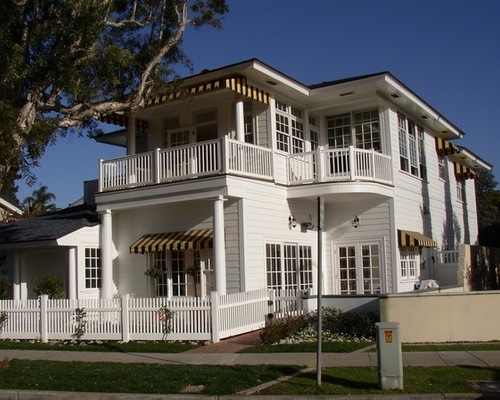Awnings are a valuable home design element that our grandparents knew all about. In the days before air conditioning, they were used to shade interiors and help keep homes cool. With the focus on sustainable design today, there’s renewed interest in the power of awnings. They block the sun from entering the house and warming it on hot days, and can be removed or retracted during the winter months when you’re craving light and warmth. Depending on the fabric you choose, they can also keep harmful UV rays from damaging your skin and fading your fabrics.

Awnings 1: Flagg Coastal Homes, original photo on Houzz
Window awnings can reduce solar heat gain in the summer by up to 65% on south-facing windows and 77% on west-facing windows, according to the U.S. Department of Energy. Besides all of that great money- and energy-saving function, awnings are an aesthetic asset. Colorful materials, stripes and scalloped edges are just a few of the options. Awnings bring softness, pattern, color and nostalgic charm to a home’s facade.
This photo shows awnings at work — you can see the shadows they create and how they’re protecting the interiors and the second-floor balcony area from the sun’s rays. Aesthetically, the stripes break up the white on the home — they are the home’s flirty false eyelashes.

Awnings 2: Christina Karras, original photo on Houzz
The retractable awning is curb appeal gold and transforms a space out front into a shady outdoor room. This style of retractable awning has poles that help support it, but there are other options that don’t require the added support.
Retractable awnings that don’t require support poles have retractable arms to support them. This provides a cleaner look. These can extend up to 14 feet.

Awnings 3: Exteriors by Chad Robert, original photo on Houzz
This style of awning, called a spear awning, adds to the style of the home. The decorative wrought iron rods have finials that pick up on the iron lantern and metal furniture frames on the patio.
These awnings are easily rolled up by hand when inclement weather is expected.(You will need to retract awnings when high winds are predicted. The awning company will let you know how many miles per hour their products can withstand.) There are also motorized versions on the market. Factors to consider when deciding whether to go hand-cranked or motorized include the ease of simply pushing a button versus the increased cost of the product, installation and maintenance.
“The motor is an up-charge and usually adds another $800 to the cost of the awning,” says Sandy Price of PYC Awnings. “The motor comes with a 12-foot cord and a plug, or you have an electrician hard-wire it for you.” (That cost is not included in the $800.) By the way, motorized awnings come with a hand crank in case the power goes out.

Awnings 4: Our Town Plans, original photo on Houzz
This roller shade protects those on the porch from the sun and wind. “It has a cable on each side that passes through rings at the bottom of the shade to keep it from flapping in the wind,” says Suzanne Stern of Our Town Plans. The shade has a crank for rolling it up and down by hand (which you can make out on the left side of this photo if you really squint).
Related: Patio Details: Awning-Covered Patio and Playhouse for a Shared Property
Stern also notes that this solution doesn’t change the look of the column and that the shade can be rolled all the way down below the railing.

Awnings 5: Becky Harris, original photo on Houzz
These valance awnings on a house on Florida’s Marco Island are more decorative than functional. They’re installed across extensive porches and tie into larger retractable awnings used in other spots on the home. “The customer used the Costa Track installation so they wouldn’t see any hardware and did a ceiling-mount installation,” Price says.
 Facebook
Facebook
 X
X
 Pinterest
Pinterest
 Copy Link
Copy Link
